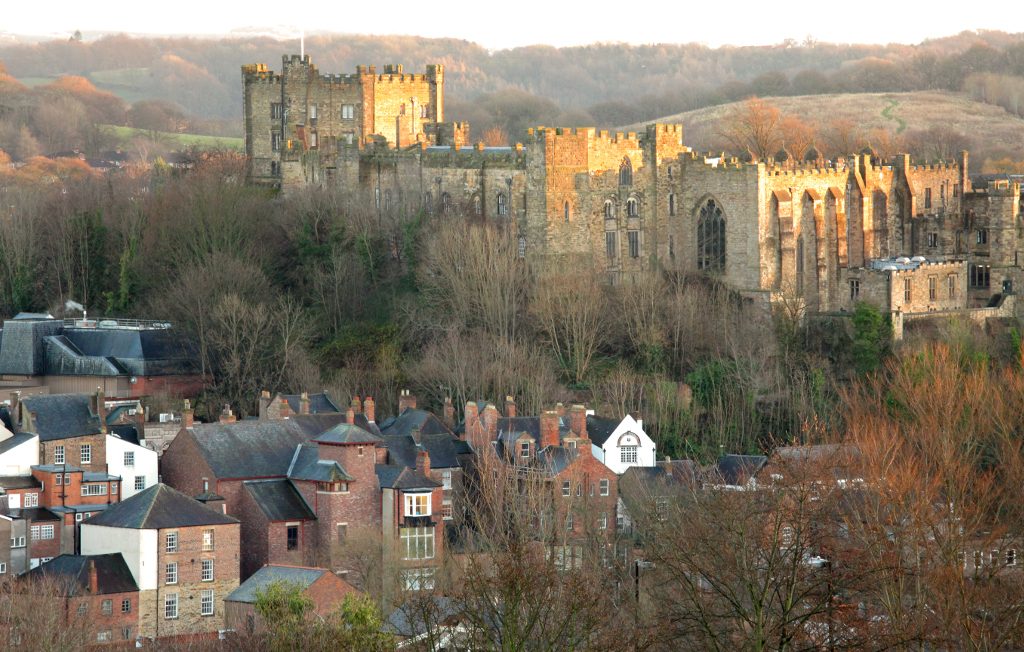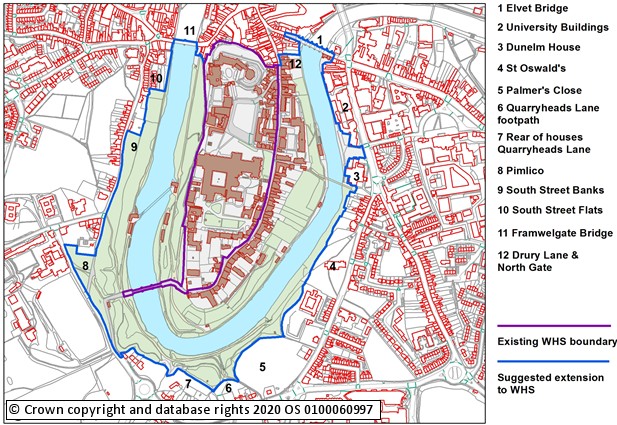Policy H1: Protection and Enhancement of the World Heritage Site
Development proposals within the Durham Cathedral and Castle World Heritage Site should sustain, conserve, and enhance its Outstanding Universal Value and to support the current adopted management plan.
Development proposals within the World Heritage Site should sustain, conserve and enhance the World Heritage Site by:
- demonstrating account has been taken of both the historical and present uses of the World Heritage Site; and
- proposing high quality design which contributes to the quality and significance of the World Heritage Site; and
- using materials and finishes appropriate to the vernacular, context and setting; and
- seeking balance in terms of scale, density, massing, form, layout, landscaping and open spaces.
Development proposals throughout Our Neighbourhood should be shown to sustain, conserve and enhance the setting of the World Heritage Site where appropriate by:
- carrying out an assessment of how the development will affect the setting of the World Heritage Site, including views to and from the World Heritage Site; and
- protecting important views; and
- taking opportunities to open up lost views and create new views and vistas.
4.42 The new management plan of the Durham World Heritage Site (2017) is now operational and runs from 2017 to 2023. It can be treated as a material document for planning purposes (particularly the Action Plan p.36 to 46). Its aims (p.4) are to:
- Protect the Site’s Outstanding Universal Value and setting;
- Conserve and enhance the Site and its setting;
- Support understanding and awareness of the Site and its Outstanding Universal Value and of World Heritage;
- Support communities in realising the economic, social and cultural opportunities and benefits World Heritage status can bring;
- Support visitor and communities’ access, their enjoyment of the Site and its benefits;
- Provide WHS management to deliver all aims.
4.43 The identification of an inner and outer setting of the World Heritage Site is to protect the site and sustain the Outstanding Universal Value. Outstanding Universal Value is “cultural and/or natural significance which is so exceptional as to transcend national boundaries and to be of common importance for present and future generations of all humanity” (UNESCO, 2008, para.49). Durham’s World Heritage Site’s Outstanding Universal Value includes the Cathedral and Castle and associated historic buildings, their landscape setting (comprising the historic City, its buildings and streets, the river and the riverbank, the green assets, and local and long distance views to and from the site), its cultural and religious traditions (historically and currently) and its meaning for people.
4.44 The management plan has a number of issues in its Action Plan (p.36-45) that have been relevant to the development of policies in the Neighbourhood Plan, as listed below::
- Objective 1.1 Ensure the protection of the OUV through planning policy and processes (Action 1.1.1 Liaise with County Durham/ Neighbourhood Plan teams to ensure they accurately reflect the OUV and attributes of the Site in Local Plans)
- Objective 2.2 Conserve the setting of the WHS and encourage appropriate and sensitive development and support the ongoing regeneration of Durham and its environs. (Action 2.2.1 Build and confirm support for an inner setting area around an expanded WHS core area in lieu of a Buffer Zone; Action 2.2.2 Increase understanding of the inner setting through views and general analysis; Action 2.2.3 Promote the use of ICOMOS Heritage Impact Assessments for new developments in and around the WHS; Action 2.2.4 Make available to prospective developers, descriptions of significance and key factors forming the character of the townscape that support the OUV of the Site; Action 2.2.6 Develop and deliver a programme of more proactive tree management along the riverbanks and upon the Peninsula and continue the conservation of the WHS riverbanks, woodlands and associated structures; Action 2.2.7 Ensure that all maintenance and development plans on the WHS pay due attention to the preservation and support of fauna and flora.
- Objective 2.3 Pursue expansion of the WHS boundary (Action 2.3.1 Review inner and outer riverbanks for potential to become new boundary of the WHS2; Action 2.3.2 Build documentary evidence in support of the conservation and restoration of these historic Green Landscapes)
- Objective 4.1 Maximise the benefits brought to the region by sustainable and appropriate use of the WHS as a visitor attraction and maximise the benefit to the WHS of the local and regional development of Durham’s tourist offer (Action 4.1.2 Integrate the WHS within local and regional tourism strategies)
- Objective 5.3 Increase visitor/user engagement with the WHS (Action 5.3.4 Develop guided walks, controlled public access and new signage and interpretation boards along the riverbanks)
- Objective 5.4 Improve physical access to and across the WHS (Action 5.4.1 Improve physical access to and around the WHS for users with disabilities and their carers. Ensure all development projects include consideration of improvements to access; Action 5.4.2 Work in partnership to support the continuation/expansion of the Cathedral Bus service; Action 5.4.3 Work in partnership to address traffic congestion on the peninsula)
4.45 The implementation plan will be undertaken by the World Heritage Site Coordinating Committee whose local representatives include Durham Cathedral, Durham University, St John’s College and University College (as landowners, Durham County Council (as a statutory consultee) and the City of Durham Trust. It is essential that the needs of all people including those with disabilities, the very old and young, are addressed when considering every aspect of the implementation plan.
Map 1: World Heritage Site Boundaries
Map 2: World Heritage Site Inner Setting
Justification
4.46 The Forum’s priority survey (Durham City Neighbourhood Planning Forum, 2015) identified that local people valued highly the World Heritage Site, the Cathedral, the Castle and Palace Green. For them a high priority is to conserve the City’s heritage. In the Forum’s study of the views of young people (Durham City Neighbourhood Planning Forum, 2016a), their priorities included heritage. The young people all had a strong appreciation of the heritage and architecture of the City and a discernible pride in the historic centre, particularly the Cathedral and Castle.
4.47 Durham Cathedral and Castle were inscribed by UNESCO as a World Heritage Site in 1986 in recognition of its Outstanding Universal Value. The Government is a signatory to the UNESCO (1972) World Heritage Convention and has a statutory duty to conserve World Heritage Sites so that they can be enjoyed by present and future generations (PPG ‘Historic environment’ para. 026 to 038). Durham County Council is a member of the World Heritage Site Coordinating Committee which manages the site. Saved policies of the City of Durham Local Plan cover protection of the World Heritage Site (E3) and extension of its area (E4).
4.48 The Site is set in an intimate landscape bowl forming the inner setting with the higher land forming the backdrop to the World Heritage Site. (See Map 2, the inner settings). The surrounding green wooded hills, ridge lines and green fingers of land which penetrate into the City create a magnificent setting for the Cathedral and Castle and include Flass Vale, Whinney Hill, Observatory Hill, Maiden Castle and Mountjoy, together with the River Wear that meanders through the City. Most of Our Neighbourhood is contained within the inner setting of the World Heritage Site. These important viewpoints contributing to the setting are identified within the County Council’s Durham City Conservation Area Character Appraisal (Durham County Council, 2016b), and must therefore be protected from inappropriate development.
4.49 Views of the Cathedral from within Our Neighbourhood are many and various: they include the well-known view from a train on the Viaduct and also the view from the railway station, Wharton Park, Observatory Hill, the University of Durham Hill Colleges, Farnley Rise, the approach to the peninsula from Kingsgate Bridge and the slip road from the Motorway to Gilesgate roundabout. Plan 2 from the Durham World Heritage Site (2017, p.19) Management Plan shows notable viewpoints (see Map 2 in the Neighbourhood Plan). This list is indicative and not exhaustive. It is essential that views of the World Heritage Site are not obstructed by new developments. The Parish Council will be preparing an updated evidence base of Our Neighbourhood, linked to further studies and progress with initiatives set out in the associated ‘Looking Forwards’ document that the Parish Council adopted alongside the Submission Draft Neighbourhood Plan. This will form part of the evidence base for a future revision of the Plan. In particular, this will include coverage of important views, lost views and new views and vistas.
4.50 The outer setting comprises the surrounding hills and ridges and wider visual context of the City. To the south the outer bowl is essentially rural with the City confined to the foreground and distant settlements situated below the horizon. To the north the character is more developed but with larger areas of open countryside. There are many vantage points from which the World Heritage Site (and its associated urban and green setting) can be viewed with varying degrees of visibility. The outer edges of Our Neighbourhood lie in the outer setting of the World Heritage Site.
Next section: Policy H2: The Conservation Areas




